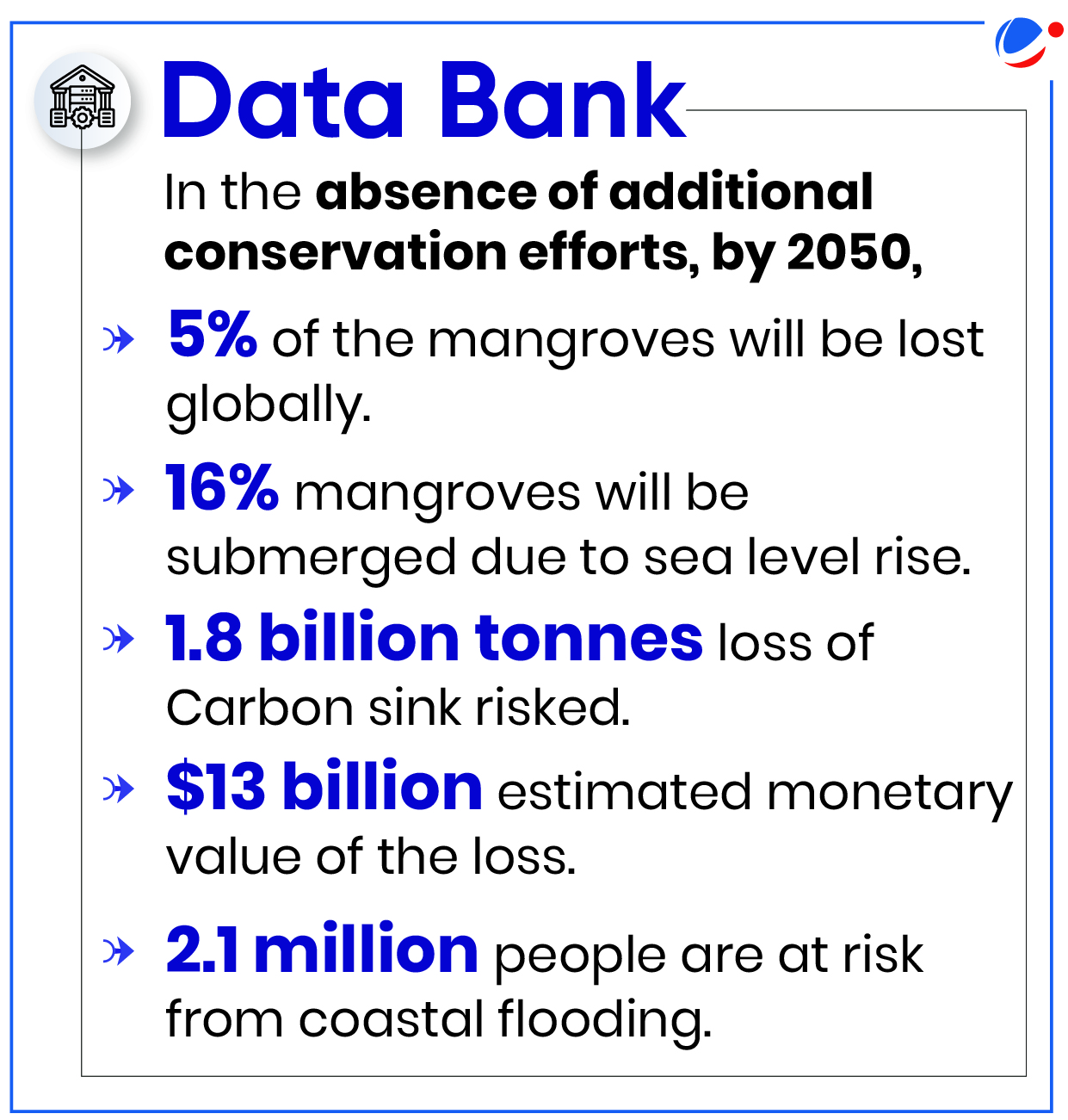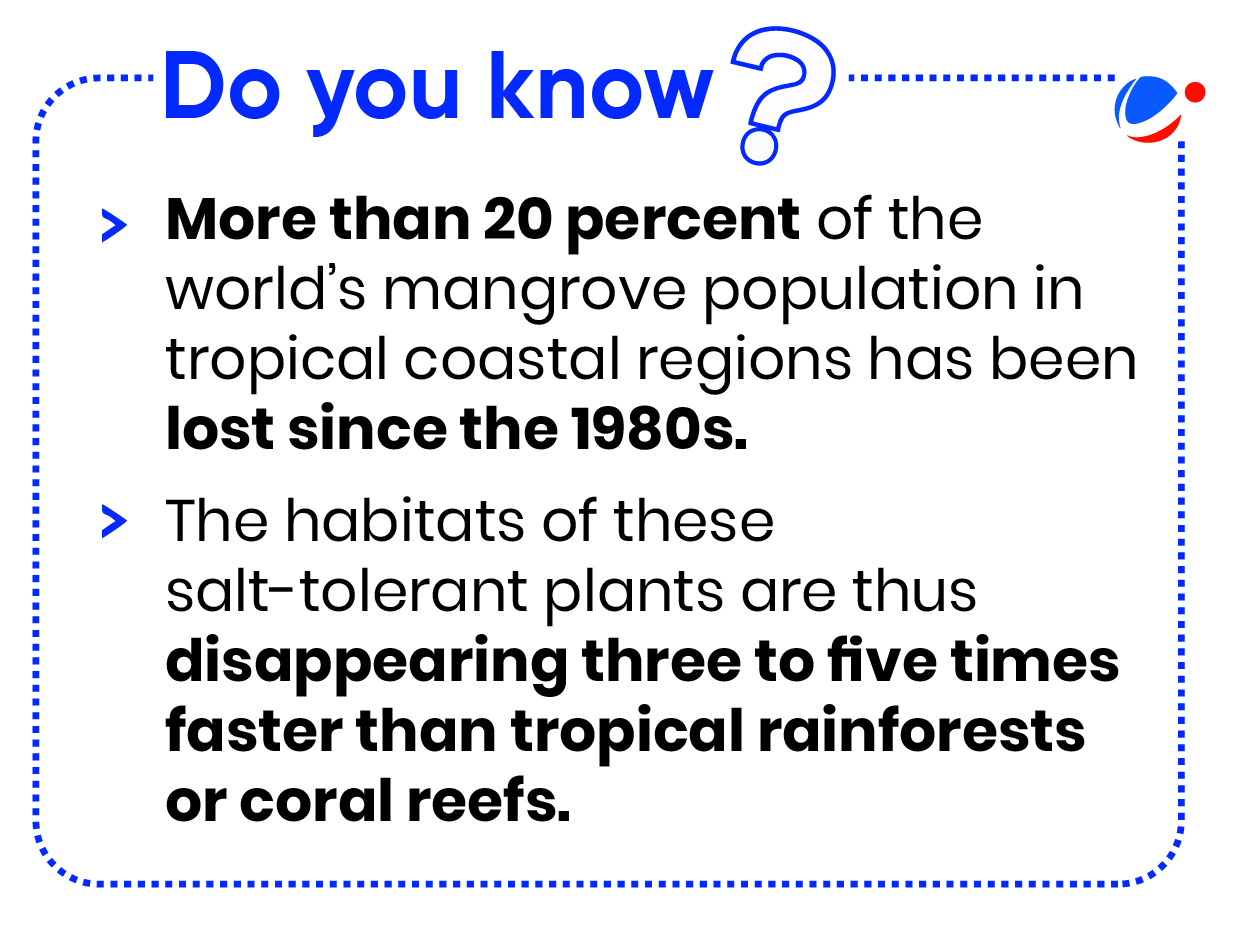Why in the News?
Recently, the IUCN Red List of Mangroves Ecosystems has indicated that about 50% of the ecosystems examined were classified as vulnerable, endangered, or critically endangered.

More on the news
- IUCN Red List of Mangroves Ecosystems assessed 36 regions across 44 countries with experts from organizations like the Global Mangrove Alliance.
- It is one of the headline indicators for the Kunming-Montreal Global Biodiversity Framework under the Convention on Biological Diversity (CBD).
- The mangrove ecosystems of south India, Sri Lanka, the Maldives and Northwest Atlantic were identified as critically endangered.
- It showed that nearly 20% of the assessed mangroves are at high risk and have been marked as endangered or critically endangered, indicating a severe risk of collapse.
- Nearly 33 per cent of the mangrove systems on the planet are threatened by the impacts of climate change.
About Mangroves and Ecosystem services provided by them
Mangrove ecosystems cover an area of 150,000 sq km, primarily on tropical, subtropical, and warm temperate coasts around the world, covering approximately 15 per cent of the world's coastlines.
- Carbon sequestration: Mangrove ecosystems sequester approximately 11 billion tonnes of carbon, which is almost three times the amount stored by tropical forests of the same size.
- Protection from coastal calamities: Healthy mangroves can combat sea level rise while also providing inland protection from extreme weather events.
- Biodiversity conservation: Mangroves support a huge variety of plants and animals.
- Of the over 1,500 species of fauna that depend on mangroves for their survival, 15% are threatened with extinction.

Threats to the mangrove ecosystem:
- Climate change: Increased frequency of severe storms and sea-level rise places mangroves at risk of extinction.
- Development-related activities: Deforestation for developmental activities like dam construction and urban development alters freshwater and sediment fluxes and damage the mangrove ecosystems.
- Pollution: Contaminants from sewage, runoff, industrial effluent, intertidal zone fishing, marine and coastal tourism, urban runoff, and marine industries impact mangrove ecosystems.
- Endocrine disruption of fauna, reduced reproduction rates, feminization of male fish, and toxic effects on human populations consuming marine produce are some of the impacts of pollution on the mangrove ecosystems.
- Unsustainable fishing: Lack of sustainable methods of fishing especially, shrimp farming impacts the resilience of the mangroves.
Initiatives for Mangrove Conservation:
- India State of Forest Report (ISFR)2023 by the Forest Survey of India (FSI): Mangrove cover in India has increased by 17 sq km (0.34%) as compared to the previous assessment.
- MISHTI (Mangrove Initiative for Shoreline Habitats & Tangible Incomes): It is a government-led initiative under the Ministry of Environment, Forest and Climate Change (MOEF & CC) aimed at increasing the mangrove cover along the coastline and on saltpan lands.
- It provides financial assistance to local communities to undertake mangrove plantations.
- Conducting awareness campaigns to educate people about the importance of mangroves and their role in protecting the environment.
- Sustainable Aquaculture In Mangrove Ecosystem (SAIME) initiative: Building aquaculture farms that use sustainable IMA (integrated mangrove aquaculture) systems.
- Magical Mangroves campaign: WWF India has enjoined citizens in nine coastal states on mangrove conservation.
- National Coastal Mission Programme on 'Conservation and Management of Mangroves and Coral Reefs': Preparation of an annual Management Action Plan (MAP) for Mangroves conservation & management.
Multilateral Cooperation: Mangrove Breakthrough
|
Way Forward
- Legal and policy measures: Strengthening of existing laws like the Indian Forest Act,1927, Environmental Impact Assessment (EIA),1986 and Forest Conservation Act,1980.
- Ecological conservation:
- Mangrove restoration by identifying regions suitable for restoration for planting mangroves.
- Establishment of green belts and buffer zones in and around the fringes of mangrove forests to maintain the ecological integrity of the core area.
- Regulation of wetland soil elevation by construction of barriers on rivers carrying sediments to conserve the mangrove habitat.
- Connecting the mangrove forest with the terrestrial forest to improve conservation efforts. E.g., Sundarban mangroves connected to the Sundarban National Park.
- Research and development: Core research and data collection about the variety of mangroves at national, sub-national or other lower scales for localized custom solutions.
- Important mangrove patches can be declared as 'Mangrove Germplasm Preservation Centres' for their better management and conservation.
- International cooperation: In line with the UN Decade for Ecosystem Restoration 2021-2030, a global political will, scientific approach, and financial resources need to be streamlined towards marine ecosystems with mangrove ecosystems in focus.



